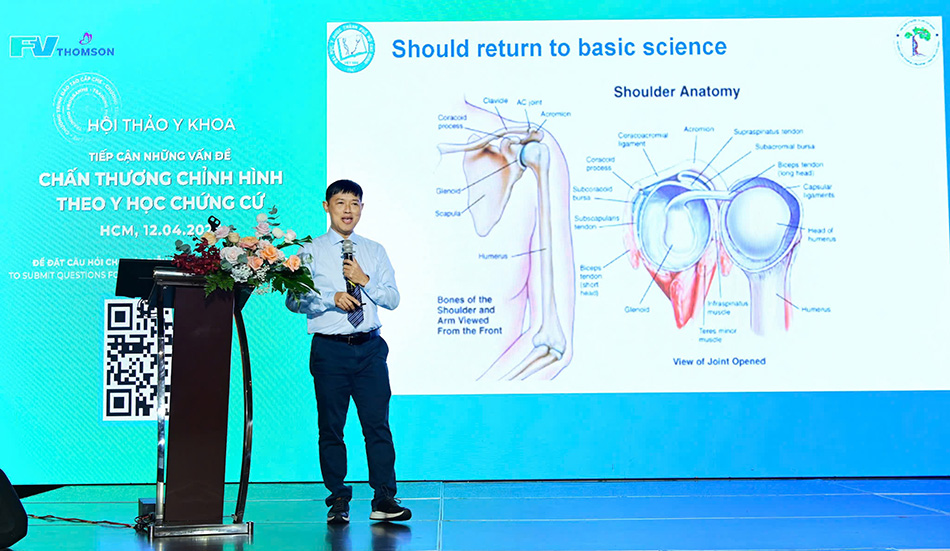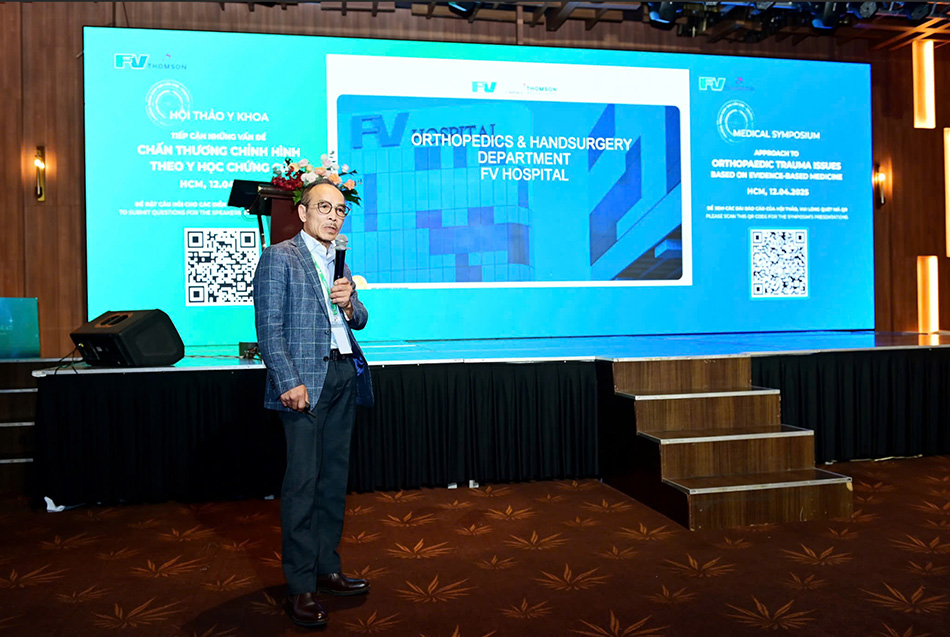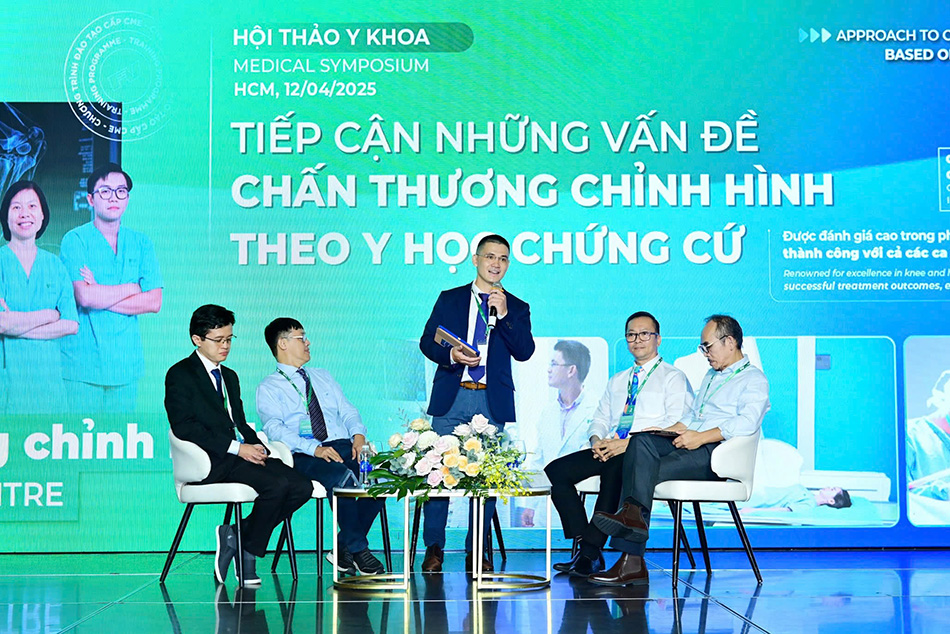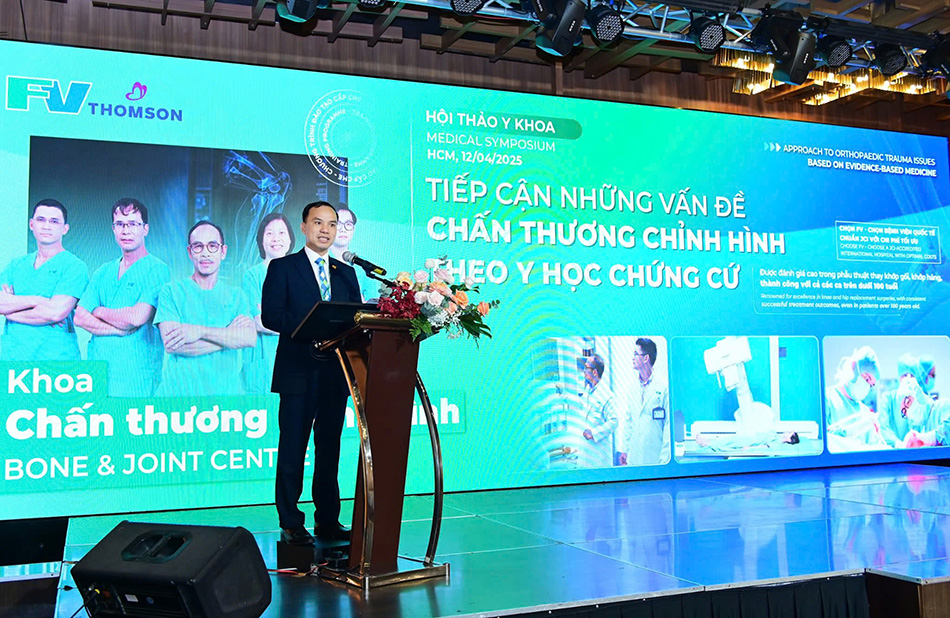Table of contents
The Continuing Medical Education (CME) seminar titled “Approach to Orthopaedic Trauma Issues Based on Evidence-Based Medicine”, recently organised by FV Hospital in Ho Chi Minh City, drew the participation of nearly 500 doctors. The event highlighted a range of recent advancements in the treatment of musculoskeletal and orthopaedic conditions, including hallux valgus, flatfoot, shoulder dislocation, and rheumatoid arthritis. The seminar also explored strategies to reduce postoperative pain for patients undergoing knee and hip replacement surgeries.
This event reflects FV Hospital’s ongoing commitment to advancing clinical practice through the adoption of globally recognised treatment methods. By sharing practical knowledge with the local medical community, the seminar aims to encourage the wider implementation of these medical innovations – ultimately improving patient outcomes in Vietnam.

Nearly 500 doctors attend the Seminar “Approach to Orthopaedic Trauma Issues Based on Evidence-Based Medicine”
The seminar featured experts in orthopaedics, rehabilitation, rheumatology, and anaesthesiology based in Ho Chi Minh City. These specialists offered multifaceted perspectives by combining the latest research with hands-on experience, helping doctors stay up to date and improve treatment outcomes for their patients.

Do Phuoc Hung, Assoc. Prof, Head of the Department of Orthopaedics and Rehabilitation at the University of Medicine and Pharmacy in Ho Chi Minh City
The seminar opened with a presentation by Do Phuoc Hung, Associate Professor and Head of the Department of Orthopaedics and Rehabilitation at the University of Medicine and Pharmacy in Ho Chi Minh City. He addressed the topic “First-Time Shoulder Dislocation: Conservative Treatment or Surgery?” – a common issue, particularly among athletes. When a patient suffers a shoulder dislocation, the joint is typically repositioned. However, the key question that follows is what to do next: should surgical intervention be pursued, or is conservative treatment sufficient to prevent recurrence?
According to Dr Do Phuoc Hung, approximately 50% of patients treated conservatively do not experience recurrent dislocation, indicating that not every first-time shoulder dislocation requires surgery. The advantage of surgery – typically arthroscopic Bankart repair – is a significantly lower recurrence rate (around 10% compared to 55% with conservative treatment), making it particularly beneficial for athletes aiming to return to competition quickly. However, surgery also carries a risk of complications in certain patients. Drawing on clinical experience, doctors can assess the need for surgery by considering several factors, including the patient’s age (with younger individuals facing a higher risk of recurrence), the extent of bone damage, the level of athletic activity, and results from physical examinations.
Hallux Valgus: A Common Condition That is Often Overlooked
In his presentation, Le Trong Phat, MD, PhD, Head of the Department of Orthopaedics and Hand Surgery at FV Hospital, discussed hallux valgus – a deformity in which the base joint of the big toe shifts outward, causing the toe to angle toward the smaller toes. This condition affects up to 23% of adults aged 18 to 65. Women are two to three times more likely to develop hallux valgus than men, with one of the main contributing factors being the frequent use of high heels. Despite its prevalence, this condition remains significantly underrecognized and is often overlooked.

Le Trong Phat, MD, PhD, Head of the Department of Orthopaedics and Hand Surgery at FV Hospital
Hallux valgus is classified into four severity levels. Mild cases are often asymptomatic, while more severe cases can cause discomfort when wearing shoes and may lead to pain due to arthritis in the big toe joint.
To treat hallux valgus, mild cases can often be managed through non-surgical methods such as changing footwear, using padding, toe separators, or orthotic splints. In more severe cases, surgery is recommended. “The goal of surgery is to realign the bones and soft tissues – ligaments, muscles.” Dr Phat explained. “If only the bones are corrected without addressing the soft tissues, the risk of failure can be as high as 90%.”

MRI Imaging and Clinical Photos Before and After Hallux Valgus Surgery at FV Hospital
According to Dr Phat, the foot contains more than 200 ligaments and tendons, making it an exceptionally complex structure. Therefore, if treated incorrectly, patients may risk losing the ability to walk. Treating foot conditions requires meticulous care and the expertise of specialists. There are over 130 surgical methods worldwide for treating this condition, with the Chevron, Lapidus, and Scarf procedures considered the most effective. The Lapidus and Scarf surgeries are recommended for more severe cases. In particular, the Scarf procedure – a challenging technique – has been shown to achieve a 92% satisfaction rate among patients. At FV Hospital, Dr Phat regularly performs this surgery, with no complications reported.
Misconceptions About Flat Feet in Children
Another foot-related issue is flexible flatfoot, presented by Dr Truong Hoang Vinh Khiem, Specialist Level II and treating physician at the Department of Orthopaedics and Hand Surgery at FV Hospital. In recent years, many parents have brought their children in for early screening and treatment of flat feet. However, according to Dr Khiem, early intervention is generally unnecessary. Studies show that nearly 94-100% of two-year-olds have flat feet, but by the age of 10, this figure drops to only 4%. This suggests that in most cases, children naturally develop a normal arch in their feet as they grow older.

Dr Truong Hoang Vinh Khiem, Specialist Level II – Orthopaedics and Hand Surgery Department at FV Hospital
There are two types of flat feet: rigid flatfoot and flexible flatfoot, the latter accounting for approximately 91% of cases. According to Dr Khiem, global studies indicate asymptomatic flat feet generally do not require any additional treatment. The use of orthotic insoles offers no proven therapeutic benefit and may even have a negative impact on a child’s psychological well-being.
Treatment for children with symptomatic flat feet is generally recommended between the ages of 8 and 13. This may involve encouraging children to walk barefoot regularly to help strengthen the foot’s structures, muscles, and ligaments, along with the use of insoles to support arch development. In severe cases – such as when a child experiences night-time foot pain, has an abnormal gait, or is prone to tripping – surgical intervention may be considered.
There are various surgical methods available, one of which is the subtalar joint elevation surgery, currently being effectively applied at FV Hospital. This procedure involves inserting a screw into the subtalar joint space to limit excessive rotation of the talus bone on the calcaneus. This is a simple procedure that takes only 5 to 15 minutes and delivers high effectiveness. “FV has performed this surgery on 50 patients with good outcomes, and the patients have been satisfied after treatment.” Dr Khiem shared.

Surgical Treatment for Flat feet at FV Hospital
Effective Pain Management Accounts for Over 50% of Orthopaedic Trauma Surgery Success
At the seminar, Ly Quoc Thinh, MD, MSc, Specialist Level II and Head of the Department of Anaesthesiology, Intensive Care & Pain Control at FV Hospital, addressed a topic of major concern for many patients: postoperative pain management following lower limb joint replacement surgery. For patients undergoing knee or hip replacement, pain is often a significant worry. Statistics show that 7-23% of knee replacement patients experience chronic pain, while the rate for hip replacement ranges from 13-44%. As such, effective pain control for patients is a key priority in improving treatment outcomes and enhancing patient satisfaction.

Ly Quoc Thinh, MD, MSc, Specialist Level II and Head of the Department of Anaesthesiology, Intensive Care & Pain Control at FV Hospital
To manage pain in patients undergoing lower limb joint replacement surgery, FV Hospital has long implemented a multimodal approach to pain control. This strategy combines medication, nerve block techniques, anxiety and depression management, and non-pharmacological methods. Early mobilisation and physical therapy have been shown to improve treatment outcomes and reduce the risk of joint stiffness. FV Hospital is also a pioneer in applying the Enhanced Recovery After Surgery (ERAS) protocol, which supports a faster return to daily activities – including encouraging movement within 24 hours after surgery.
Dr Thinh also emphasised the important role of the surgeon in pain management: performing minimally invasive procedures to reduce tissue damage and limiting surgical time to under three hours are key factors. These are practices that FV surgeons carry out with a high level of expertise.
The Goal Is to Achieve a Definitive Cure for Rheumatoid Arthritis in the Near Future
The treatment of rheumatoid arthritis (also known as rheumatoid polyarthritis) was discussed. This chronic inflammatory joint disease affects the synovial membrane, leading to the destruction of cartilage and bone, and can ultimately result in disability. It affects approximately 1-2% of the population.

Nguyen Chau Tuan, MD, MSc, from the Department of Internal Medicine – Rheumatology, University Medical Center Ho Chi Minh City
Dr Tuan emphasised the importance of early diagnosis and early treatment for patients with rheumatoid arthritis. As the condition can have various causes, personalised treatment is essential. Management typically involves a combination of medication, physical therapy, and in cases of joint deformity, surgery may be necessary. “The ultimate goal of treating rheumatoid arthritis is to control the disease, prevent complications, and preserve the patient’s quality of life,” Dr Tuan noted.

The speakers addressed questions from seminar attendees
The seminar organised by FV Hospital was highly praised by attending experts and doctors for the practical value of its evidence-based presentations. “This seminar is very beneficial. With the rapid development of science today, young doctors really need to participate in such seminars to gain more valuable knowledge. Personally, I have also updated my knowledge to apply in treating my patients,” shared Ms Nguyen Thi Chien, former lecturer at Ninh Binh Medical College.

Vu Truong Son, MD, MSc – Medical Director of FV Hospital
Speaking at the seminar, Vu Truong Son, MD, MSc – Medical Director of FV Hospital, shared: “With the extensive clinical experience and research background of the speakers, we believe today’s seminar will offer new perspectives and opportunities to share challenges in surgical practice. More importantly, it is a great occasion for doctors to assess FV’s treatment capabilities and strengthen collaboration with us. Through that, we can adopt approaches that shorten recovery time and improve patients’ quality of life.”
On the sidelines of the seminar, Dr Do Phuoc Hung, Associate Professor and Head of the Department of Orthopaedics and Rehabilitation at the University of Medicine and Pharmacy, Ho Chi Minh City, emphasised the importance of evidence-based medicine: “In terms of evidence-based medicine, there are many tools that guide us in choosing the right treatment approach – especially in this era of overwhelming information that can easily lead us astray. Evidence-based medicine enables doctors to make more informed decisions and develop more effective treatment plans.”



